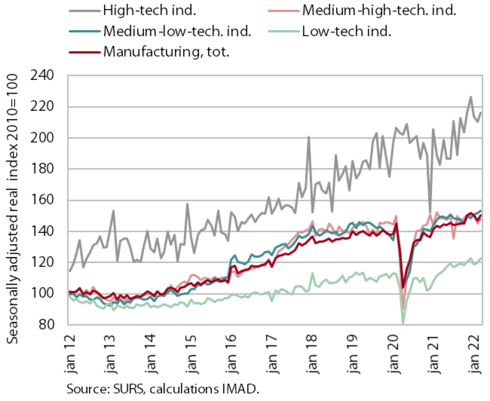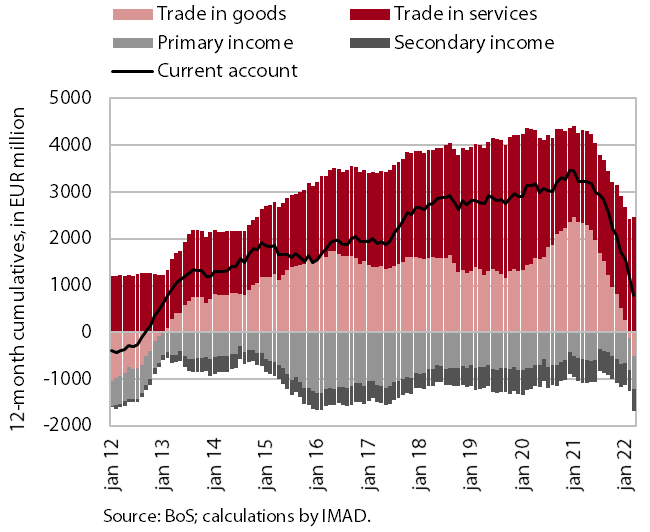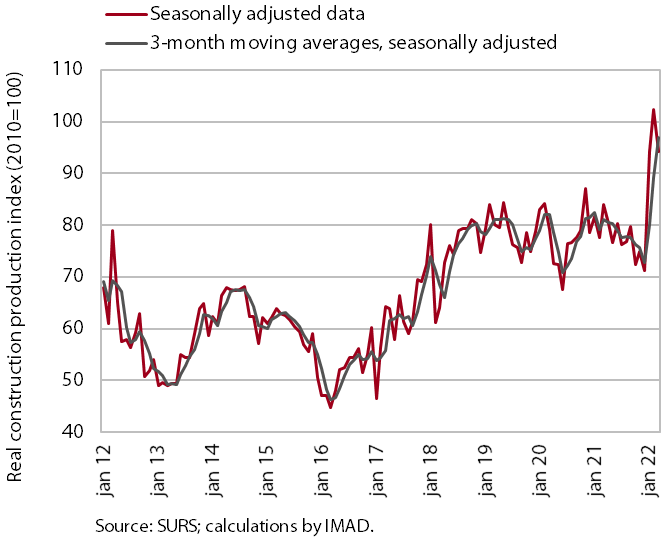Charts of the Week
Current economic trends from 9 to 13 May 2022: manufacturing, the balance of payments and construction
In the first quarter of this year, manufacturing output remained unchanged from the previous quarter, while it was still significantly higher year-on-year. After a gradual decline last year, the value of construction put in place increased significantly in the first quarter, after a long time also in non-residential construction. Cost pressures in construction are further intensifying. After several years of surplus, the current account of the balance of payments turned to a deficit in the first quarter amid high domestic spending and the deterioration of the terms of trade.
Manufacturing, March 2022

Manufacturing output in the first quarter of this year remained unchanged from the previous quarter. The slowdown in growth was due to lower activity in the first two months of the year, followed by an increase in activity in March. In the first quarter, both high- and medium-high-technology industries recorded a decline, while production volume in medium-low-technology industries increased. On a year-on-year basis, manufacturing output increased by 5.8% in the first quarter, which is slightly slower growth than in the previous quarter. High year-on-year growth was recorded mainly in high- and low-technology industries, while the increase in production volume in medium-high-technology industries was very modest. This is due to the continued unfavourable conditions in the automotive industry, which again suffered a sharp year-on-year decline in production volume in the first quarter of the year, but also to the problems faced by a major Slovenian car manufacturer.
The balance of payments, March 2022

After running a surplus for 10 years, the current account of the balance of payments recorded a deficit in the first quarter of this year. This was mainly due to the balance of trade in goods, which turned from a surplus to a deficit as imports of goods grew faster than exports in the face of stronger domestic consumption and deteriorating terms of trade. We estimate that the deterioration in the terms of trade in the first quarter of 2022 contributed EUR 200 million to the year-on-year change in the balance of goods trade (EUR 1,030 million). Net outflows of primary income also contributed somewhat to the deficit in current transactions, mainly due to higher payments of taxes on production to the EU budget. The growth of the services surplus continued, mainly in travel and transport services. The deficit in secondary income was lower year-on-year, particularly due to lower VAT- and GNI-based contributions to the EU budget. The 12-month current account surplus on the balance of payments stood at EUR 792 million in March (1.4% of estimated GDP).
Construction, March 2022

According to figures on the value of construction work put in place, activity in construction increased in the first quarter. After a gradual decline in 2021, the value of construction put in place increased at the beginning of 2022 and was 12.3% higher in March than a year ago. After a long period without growth, activity in non-residential construction recorded a strong increase in the first quarter; this is also the construction segment to have contracted most markedly last year. Activity also increased in the construction of residential buildings and in civil-engineering works, while it contracted slightly in specialised construction activities.
Cost pressures continue to intensify. The implicit deflator of the value of construction put in place (used to measure prices in the construction sector) further increased to 17.6% in March, the highest level in 20 years. According to data on business trends in construction, high material costs were reported as a limiting factor by more than 70% of companies in April, and material shortage was reported by more than 40% of companies. The values of both indicators increased sharply over the past year and reached their highest levels in 20 years in April.
